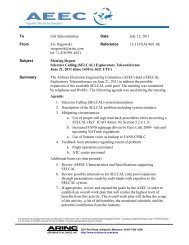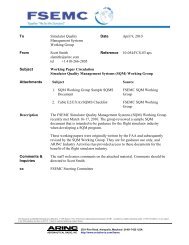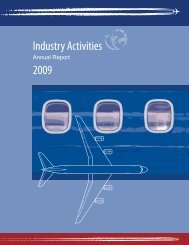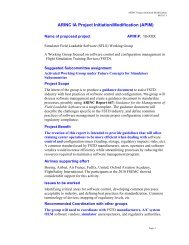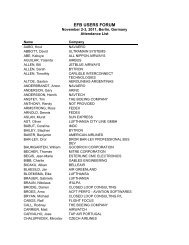(AGIE) Using Internet Protocols - Aviation Committees - AEEC - AMC
(AGIE) Using Internet Protocols - Aviation Committees - AEEC - AMC
(AGIE) Using Internet Protocols - Aviation Committees - AEEC - AMC
- No tags were found...
You also want an ePaper? Increase the reach of your titles
YUMPU automatically turns print PDFs into web optimized ePapers that Google loves.
4.0 <strong>AGIE</strong> FUNCTIONAL SPECIFICATIONARINC PROJECT PAPER 830 – Page 452. Urgent user small messages3. Urgent user large messages4. Normal coordination or user small messages5. Normal coordination or user large messages<strong>AGIE</strong> priority nominal behavior for <strong>AGIE</strong> user priorities, when used with basic <strong>AGIE</strong>priorities, shall be as defined below with highest priority first and lowest priority last.1. Urgent coordination have highest system priority2. Urgent user small messages3. Urgent user large messages4. Normal – Very high5. Normal – High6. Normal – Medium7. Normal – Low8. Normal - Background4.4.4.3 Priorities in Functions<strong>AGIE</strong> computing functions affect prioritization at the <strong>AGIE</strong> service and AMQP layers.<strong>AGIE</strong> server computing processing affects and manages prioritization in three ways.1. Best path selection considers priority setting and influences QoS2. <strong>AGIE</strong> and AMQP orders queues based on priority settings3. <strong>AGIE</strong> and AMQP feeds/meters data from queues to network based onpriority settingBest path selection is determined by priority setting and mapping table managed byoperator admin. Path selection is a key element of prioritization. Path selectiondetermines the datalink and type of service. Path selection is implemented byAMQP mapping to default or source-destination routing on the IP network between<strong>AGIE</strong> servers/AMQP brokers. Paths are defined by their connection profile name.<strong>AGIE</strong> sets the priority for messages, which may be treated anywhere from near realtimeto background message priorities. The priority settings determine how AMQPqueues and transmits the messages relative to other messages. Segmentedmessages are queued multiple times for each individual segment.4.4.4.4 Background Priority<strong>AGIE</strong> supports the concept of background messaging using a “background priority”.Background priority allows the operator to minimize cost and QoS impacts ofsending less important (time criticality) messages, especially large ones, by longtermscheduling. The actual mapping of background priority features is left tooperator admin, but it includes the ability to hold a message until specified time orcondition exists. Examples would be only allowing transmission over grounddatalinks, metering traffic during phase of flight, or sending over a lower class ofservice. Again, the special feature of background priority is the ability to hold offinitial message sending from the origination host or home server.4.4.4.5 Priorities with NetworkThis standard is developed to support priority managed networks and datalinks.However, <strong>AGIE</strong> does not require them for operation. <strong>AGIE</strong> does not have control



